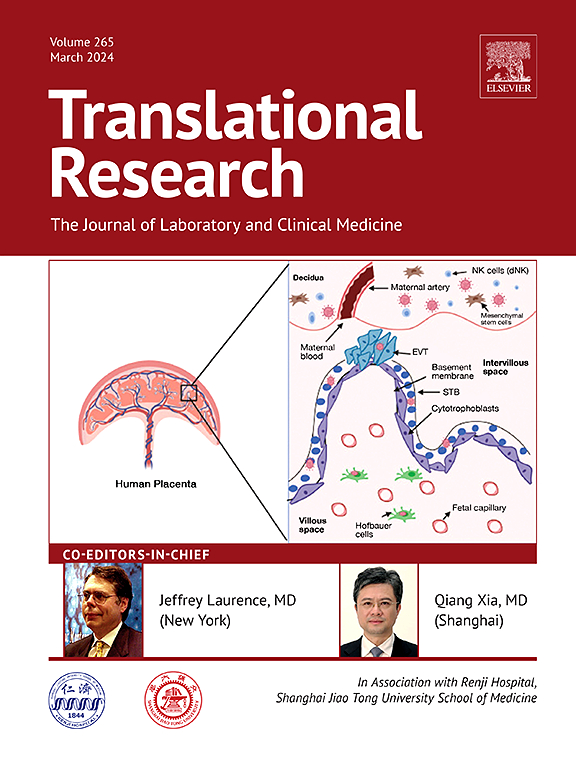Soluble ST2 is an early marker and treatment target for hypertensive nephrosclerosis signatured in glomerular mesangial cells
IF 5.9
2区 医学
Q1 MEDICAL LABORATORY TECHNOLOGY
引用次数: 0
Abstract
The absence of a biologic marker for hypertensive nephrosclerosis (HN) remains a challenge. This study aimed at exploring the relationship between sST2 and early HN and examining their interaction in glomerular mesangial cells. The serum sST2 levels of healthy controls (HC; n=9), patients with HN (n=15), and patients with lupus nephritis (LN; n=27) were measured using ELISA. The association between the serum sST2 levels and clinicopathologic characteristics, including kidney function and mesangial proliferation, were assessed. The expression of ST2 and fibrotic markers in glomerular mesangial cells in hypertensive conditions was evaluated using a 5/6 nephrectomy rat model. To mimic intraglomerular hypertension, human primary glomerular mesangial cells (hPGMCs) were subjected to a 3-mmHg pressure using a newly developed mechanical pressurizing device. The cells were then treated with anti-ST2 antibody (0.5 and 1 μg/mL) to examine inflammation, apoptosis, and necrosis. The serum sST2 levels were significantly higher in the HN and LN groups than in the HC group. Increased expression of ST2 and fibrotic markers in glomerular mesangial cells was observed in the hypertension-induced animal model. In the in vitro study, pressure-stimulated hPGMCs exhibited increased population of early and late apoptosis, which were markedly reduced after treatment with anti-ST2 antibody (1.0 μg/mL). ST2 indicates the early pathologic changes of hypertensive kidney damage and may serve as a mesangial cell-specific marker for HN in terms of determining kidney function and pathologic findings. Thus, ST2 blockade could be a novel therapeutic approach for HN.
可溶性ST2是肾小球系膜细胞中高血压性肾硬化的早期标志物和治疗靶点。
缺乏高血压性肾硬化(HN)的生物学标志物仍然是一个挑战。本研究旨在探讨sST2与早期HN的关系,并探讨其在肾小球系膜细胞中的相互作用。健康对照组血清sST2水平(HC;n=9), HN患者(n=15),狼疮性肾炎患者(LN;n=27),采用ELISA法测定。评估血清sST2水平与临床病理特征(包括肾功能和肾小球系膜增殖)之间的关系。采用5/6肾切除大鼠模型,观察高血压患者肾小球系膜细胞中ST2和纤维化标志物的表达。为了模拟肾小球内高血压,使用一种新开发的机械加压装置对人类原发性肾小球系膜细胞(hPGMCs)施加3mmhg的压力。然后用抗st2抗体(0.5和1 μg/mL)处理细胞,观察细胞的炎症、凋亡和坏死。HN和LN组血清sST2水平明显高于HC组。在高血压动物模型中,观察到肾小球系膜细胞中ST2和纤维化标志物的表达增加。体外实验中,压力刺激的hPGMCs出现了早期和晚期细胞凋亡的增加,抗st2抗体(1.0 μg/mL)处理后细胞凋亡明显减少。ST2提示高血压肾损害的早期病理改变,可作为肾小球系膜细胞特异性标志物,用于确定肾功能和病理表现。因此,ST2阻断可能是一种治疗HN的新方法。
本文章由计算机程序翻译,如有差异,请以英文原文为准。
求助全文
约1分钟内获得全文
求助全文
来源期刊

Translational Research
医学-医学:内科
CiteScore
15.70
自引率
0.00%
发文量
195
审稿时长
14 days
期刊介绍:
Translational Research (formerly The Journal of Laboratory and Clinical Medicine) delivers original investigations in the broad fields of laboratory, clinical, and public health research. Published monthly since 1915, it keeps readers up-to-date on significant biomedical research from all subspecialties of medicine.
 求助内容:
求助内容: 应助结果提醒方式:
应助结果提醒方式:


